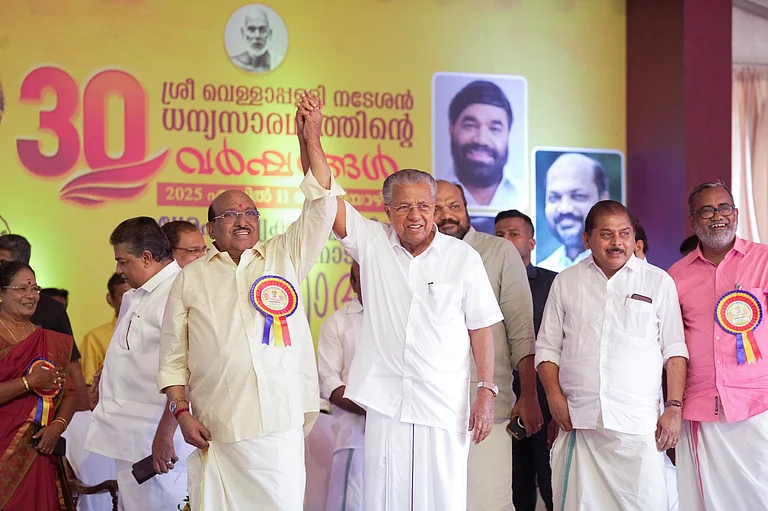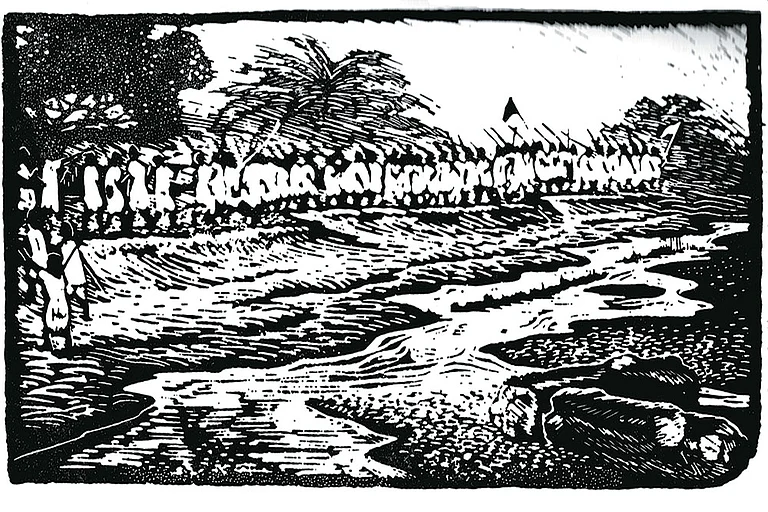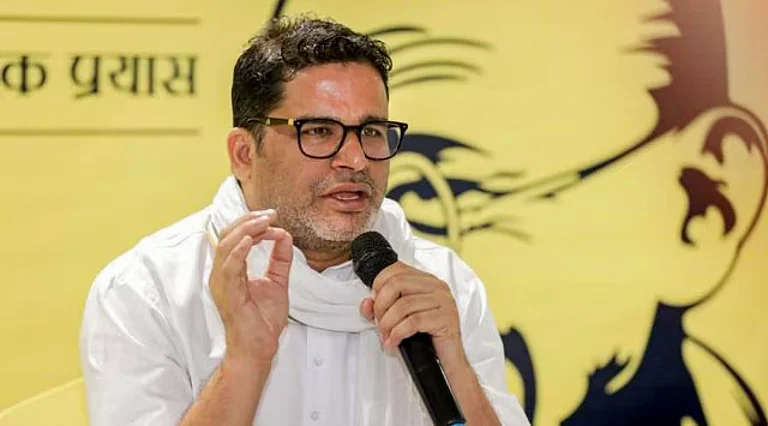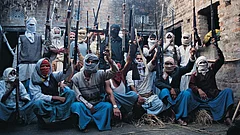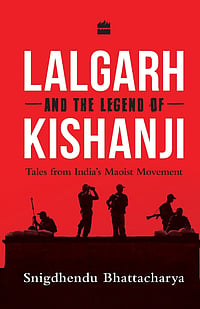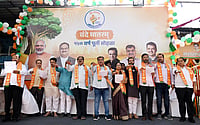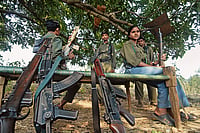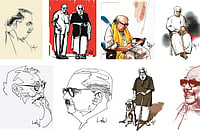"Who doesn’t know Dipankar Bhattacharya?” asks Santosh Kumar Singh, a Patna-based middle-aged and soft-spoken cab driver, looking at me through the rearview mirror with disdainful eyes for asking a silly question. “Everybody knows him by his salt-and-pepper beard and back-brushed hair,” he says.
I was curious. Bhattacharya is known for his looks, and not politics? “Yes, politics, of course,” Singh says, as he navigates through a bumpy and potholed road in Bhojpur district of southwestern Bihar.
It’s a hot summer evening in June 2025. The sun is about to set, but the air is breathing fire. Google says it feels like 47° Celsius. While concentrating on the road, he keeps narrating how ‘Maley’ leaders are respected because they have always sided with the poor, live simple lives and have not been involved in corruption.
Bhattacharya is the general secretary of the Communist Party of India (Marxist Lenininist) (Liberation), or CPI(ML)(Liberation) in short, which has become Ma-Le or ‘Maley’ in local parlance. It is India’s only Leftist party that has tasted electoral success after an underground stint of armed struggle in the 1970s and 1980s, followed by a phase—during the 1980s and 1990s—when the party contested elections and also maintained armed squads.
During the 11 years of Prime Minister Narendra Modi’s Hindu nationalist rule, it is thanks to this party that Bihar became the only state where the Left forces marked any noticeable growth.
After winning 12 assembly seats in the 2020 Bihar elections—its best performance since entering the electoral fray in 1985—Maley maintained the momentum by winning two Lok Sabha seats in 2024, which too is its best electoral show. The party also won two seats in the 2024 Jharkhand assembly election.
Whether for Bhattacharya’s beard and hair style or the party’s politics, the Bihar-based Leftist party has drawn a lot of public attention in recent years. Riding on these electoral successes, the party has expanded organisationally through mergers with the Jharkhand-based Marxist Coordination Centre (MCC) and the Maharashtra-based Lal Nishan Party (LNP).
In Bihar, Bhattacharya has emerged as one of the most visible faces of the Rashtriya Janata Dal (RJD)-led Mahagathbandhan or the Grand Alliance of opposition parties. Singh believes the RJD is using Maley’s clean image to negate its own legacy of corruption during Lalu Prasad Yadav’s family rule of almost 15 years since 1990.
Our destination, Ekwari village in Sahar block, also interests him—because here stands the tiny house of Ram Naresh Ram, one of the founders of the Naxalite movement in Bihar who later served four terms as the MLA of Tarari.
Caste-based identity politics has weakened the left’s class-based politics. the appeal of ideology reduced after the 1990s.
From 1995 till his death in 2010, Ram led Maley’s team of 5-7 MLAs in the Bihar assembly. Singh has heard a lot about Ram’s frugal lifestyle and seen the photos of his tiny house in media reports, but had not got a chance to see it with his own eyes.
At Ekwari, Ram’s old companion, Parmeshwar Rawani, is full of fond memories of his favourite leader. Rawani remembers how the Maley’s struggle helped the local lower-caste, landless peasantry earn basic rights like sitting on chairs and cots, drinking from common water sources, getting proper wages and the right to vote.
Since the early 1970s, Ekwari and its neighbouring villages in Sahar and Tarari blocks have seen a lot of bloodshed in clashes between the landed upper-caste population and the landless or marginal land-owning lower-caste population, as the latter tried to assert their social, economic and political rights. Tarari assembly constituency, of which Ekwari is a part, emerged as a Maley stronghold, electing the party’s candidates six out of seven times from 1995 to 2020.
Legacies of good work in the past, though, are not a guarantee for winning the next election. Ekwari stands out as an example. In the May 2024 Lok Sabha election, Tarari’s two-term incumbent MLA, Sudama Prasad, got elected from the Arrah Lok Sabha seat. His resignation from the assembly necessitated the November 2024 assembly bypoll, in which PM Modi’s Bharatiya Janata Party (BJP) wrested Tarari by a margin of 10,612 votes.
“It was for the first time in two decades that our party trailed in the Ekwari panchayat area. It was by a thin margin of 49 votes, but we trailed nonetheless,” says Bhola Yadav, a marginal farmer. Maley organisers allege that the BJP pumped in a lot of money and resources to buy votes. “They are seeing a threat in us,” says Yadav.
New Wave?
The Left, which was a formidable force in Bihar in the 1990s, is not even a shadow of its past. The armed struggle of the Magadh-Bhojpur region has withered and the electoral influence has diminished too.
In 1990 and 1995, the cumulative assembly tally of the Left parties—the CPI, CPI(M) and Maley—stood at 30 and 34, respectively (excluding parts that formed Jharkhand since 2000). The CPI alone had bagged 19 seats in 1990 and 24 in 1995. In 1989, the Left parties won six Lok Sabha seats in Bihar—the CPI four and the CPI(M) and Maley one each. In 1991, the CPI won seven Lok Sabha seats, while the CPI(M) retained its sole berth.
From there, the CPI has weakened so much—largely due to the rise of the Mandal Commission-triggered caste-based politics in the 1990s—that in the 2020 assembly election, the RJD-led Grand Alliance gave the CPI and CPI(M) only six and four seats, respectively, in the 243-member house. The parties won two seats each. In the 2024 Lok Sabha elections, the Grand Alliance partners gave them one seat each out of the total 40. They failed to win any.
While the CPI failed to retain much of its lower-caste and middle-caste—communities that fall between the traditional upper and lower castes—support base and almost completely lost ground in the Magadh region south of the river Ganga, the Maley, which worked predominantly among the Dalits (Scheduled Castes), managed to significantly retain its base in Bhojpur and Magadh created during the days of the armed struggle.
The land and wage-related militant struggles have now taken a backseat, even though the party keeps raising issues concerning sharecroppers and marginal farmers. They are trying to work among migrant labourers and workers in the unorganised sector. Old caste equations—especially the conflict between the Dalits (lower castes) and the middle castes—are being ignored.
The party is also trying to expand its support base among the lower middle class. They launched Vyavsayee Mahasangh, an organisation of small traders and street vendors, highlighting that the small traders of Bihar were “reeling under acute economic crisis and growing physical insecurity in the face of Bihar’s rising crime graph” under Janata Dal (United) chief Nitish Kumar’s BJP-backed government. At present, their main call is to topple Kumar’s government.
In Tarari’s neighbouring Sandesh constituency, once a Maley stronghold that the RJD breached from 2010 onwards, Maley activists are not sitting idle either. The Maley still has about 10-13 per cent of the vote share, which came handy for the RJD in clinching the seat in 2020. Similar is the case of Jagdishpur—another constituency where the Maley has retained a 10-13 per cent vote share for over two decades and helped secure RJD’s victory in 2020.
At Ghorahuan village in Masaurhi block, roughly 40 km south of Patna, over a dozen men are relaxing under the canopy of large trees. Some are clad in only a gamcha or lungi, some have their vests on. A few of them were reading leaflets and a tabloid-size newspaper in Hindi—Lokyudh, Maley’s fortnightly Hindi mouthpiece.
“Are you all Maley supporters?” I ask. “Yes, all of us,” Raghu Paswan, a middle-aged man, says enthusiastically. Then, with a pause, he points at another middle-aged man and says, “Except for him. He recently turned to the BJP.” Others laugh and curse him in a friendly way.
I ask, “So, the BJP is eating into your support base?” They laugh. “Not in this village. We’ve been here for 50 years and still going strong.” Someone added, “No matter who wins, we vote for Maley. They taught us to fight for self-respect.”
About a hundred metres from the place, a martyrs’ column, indeed, affirms the Naxalites’ five decades of presence. It’s a small structure, dedicated to the 15 members of a Maley squad who were killed during a police encounter in May 1975. Despite such a setback, Ghorahuan, which is part of Masaurhi assembly constituency, remained a Maley stronghold.
“We are not concerned about which party is going to get the Mahagathbandhan ticket here. We are focused on making people aware of the failures of the Nitish government and the anti-people policies of the Modi government,” says Nageshwar Paswan, whose elder brother, Girja, was among the squad members killed in 1975. He joined Maley soon after, and now serves as a member of the party’s Patna district committee.
Making of a Movement
Despite leading militant land-based struggles in the 1940s against powerful estates—such as the Dumraon Raj in the villages of Chaugain and Jagdishpur of Bhojpur region, Tekari Raj in Gaya and Darbhanga Raj in Darbhanga district—the CPI’s growth in Bihar was impeded by the strong presence of socialists led by Jayaprakash Narayan.
As the socialists gradually turned more centrist, the communist parties found a new space they could occupy. The 1964 split did not impact the CPI much in Bihar, as the newborn CPI-M remained marginal in the state. The militant food movement during Bihar’s 1966 drought and famine increased the Left’s appeal among the poor. The districts of Begusarai, Madhubani and Champaran north of the Ganga, and Nalanda, Jehanabad and Patna to the south of the river emerged as their strongholds.
The Naxalite movement added new vigour with the introduction of armed struggle. While the Raj Kishor Singh-led movement in Mushahari block in Muzaffarpur district of north Bihar was making news since April 1968, Naxalites also started landing in southern Bihar from Bengal—Narayan Sanyal (Naveen Prasad alias Bijoy da) and Subrata Dutta (Jauhar) came in 1968, for example. The Charu Majumdar-led CPI(ML), launched in April 1969, had a Bihar unit right from the beginning.
After the early setback of 1970-71, the pro-Charu Majumdar cadres—mostly from the Jehanabad-Palamu region—regrouped under Sanyal’s leadership. This entire new leadership, except for Jauhar, got arrested by 1973. In 1974, Jauhar, Vinod Mishra and Swadesh Bhattacharya re-organised the pro-Majumdar faction of the CPI(ML). This party subsequently came to be known as Maley.
Two more forces started growing during the decade. Naxalite leaders who had not joined the CPI(ML) launched the Maoist Communist Centre (MCC) in October 1969 under the leadership of Kanai Chatterjee. In 1970, the MCC decided to shift its base from Bengal to Bihar and sent a comrade named Bharat to build the party in the Gaya-Aurangabad-Palamu-Chatra-Jehanabad belt. Chatterjee himself relocated to Bihar soon after.
Sanyal and others, after their release from jail in 1977, formed a new CPI(ML) faction in 1978. It subsequently became known as CPI(ML)(Party Unity) or the PU.
In a place where the land ownership pattern was highly skewed in favour of the higher castes, the conflict that unfolded for two decades thereafter drew the nation’s, and even international attention.
Bloodied Battlefield
At Kamta village in Arwal district, Maley organisers are busy carrying out village-level campaigns, organising rallies with the slogan Badlo Bihar, Badlo Sarkar (Change Bihar, Change the Government). Kamta stands next to Laxmanpur-Bathe, the site of the infamous 1997 massacre in which the Ranvir Sena, a notorious private army of Bhumihar and Rajput landlords, killed 61 Dalits.
“The massacre shocked people. It was unbelievably horrible. But it did not crush the movement. We are still here, but the Ranvir Sena is long gone,” says Surendra Prasad, a Maley organiser in his 60s. The party currently holds the Arwal assembly seat, which includes both Kamta and Laxmanpur-Bathe.
Both villages lie on the southern bank of River Sone. Just opposite Bathe, on the other side of the river, Bathani Tola in Tarari block witnessed another bone chilling massacre by the Ranvir Sena in which 21 persons—women, children and the elderly—were killed in broad daylight in 1996. Maley still enjoys good support in Bathani Tola, too.
Bihar has also witnessed the launch of a series of caste-based private armies of landlords—the Kunwar Sena of Rajput landlords in Bhojpur region and the Kisan Suraksha Samiti of Kurmi landlords in the Magadh region in 1979; the Bhumi Sena of Kurmi landlords and the Lorik Sena of Yadav landlords in Magadh region in 1983; the Brahmarshi Sena of the Bhumihars in Bhojpur-Magadh region and the Kisan Sangh of the Rajputs in southern Magadh in 1984; the Kisan Sewak Samaj of the Rajputs in 1985; the Sunlight Sena of the Rajputs in 1989 and the Sawarna Liberation Front (SLF) of the Bhumihars in 1990—all in southern Magadh; and the Kisan Sangh of the Bhumihars and the Kisan Morcha of the Rajputs in Bhojpur in 1990.
Armed conflicts between these private armies (often backed by the police) and Naxalite groups like Maley, PU and the MCC turned Bihar into India’s killing fields. A 1983 report, And Quiet Flows the Ganga: A Documentary Report on the Political Killings in Rural Bihar, published by the People’s Union for Democratic Rights (PUDR), listed 163 killings due to agrarian tension from 1980 to 1983. “The inequitable distribution of land and more specifically the low wages are at the root of these tensions,” it said.
The scene became gorier thereafter. The CPI(ML)(People’s War) or the PW, which was formed in Andhra Pradesh in 1980, opened its Bihar unit in 1993 and the Ranvir Sena, the most notorious of all private armies in the state, was launched in 1994, operating in the districts of Bhojpur, Patna, Jehanabad, Rohtas, Aurangabad and Gaya. The cumulative death toll from their massacres and Naxalite counter-attacks crossed 900 from 1977 to 2001.
But Naxals were not only fighting the police and private armies, they were also fighting rival Naxal groups. The PW alleged in September 2002 that Maley had killed more than 40 of its cadres or squad members in the previous couple of months. In 2010, Maley alleged that it had lost “no less than 224 comrades”, including supporters, activists and leaders, in attacks by rival Naxalite groups—127 of them in Jehanabad-Arwal alone; 66 at the hands of PU cadres, 21 in MCC attacks and 40 in offences by the PW.
The PW, PU and the MCC killed each other’s cadres as well. The CPI, too, came in conflict with them, especially in Jehanabad, a CPI bastion that the party won six out of nine times between 1962 and 1996, including four consecutive victories for Ramashray Prasad Singh since 1984. The Naxalite groups, especially Maley, held Singh as “the well-known ‘brain’ behind the Lorik Sena”.
The might of the Maoists increased when the CPI(Maoist) emerged in 2004 through the merger of the PU, the PW and the MCC. The very next year, the newborn party made national headlines with the sensational Jehanabad jailbreak, during which they killed 12 jailed Ranvir Sena activists and freed over 300 of their comrades.
However, the high tide receded soon, and within just a few years, the Maoists almost vacated the Magadh-Bhojpur belt and shifted to the forested terrains of Jharkhand.
New Era, New Challenge
Caste-based identity politics had weakened their class-based politics, admits Haridev Thakur, a state committee member of the CPI. He says that the appeal of ideology reduced after the 1990s and the young generation has become more self-centred, hankering after glamour and quick success.
“People are saying the CPI guys are good people and they don’t accept bribes and hence wouldn’t be able to get their work done,” he says, adding, “The normalisation of corruption has affected our politics.”
Patna-based journalist-turned-social activist Nivedita Jha thinks that the Left’s revival is important for Bihar because in an era of politics and elections dominated by caste equations and money power, they are the only ones raising the real issues affecting the marginalised people.
She points out the Left’s movements on the issues of wages of cooks in schools and anganwadi centres, voters’ rights, citizenship screening and the collapse of the Mahatma Gandhi National Rural Employment Guarantee Act (MGNREGA) with shrinking funds, which, in turn, has triggered more work-related migration.
She feels that the Left, especially the CPI, needs to adapt to the new situation of the dominance of caste and money equations and formulate new tactics to revive its influence. “The Left can possibly do better if they operate as a block to develop mass movements,” she says.
MORE FROM THIS ISSUE
In Jungle Raj, Outlook’s August 1 issue, we explored why the Bihar elections matter so much. Our reporters delved into the state’s caste equations, governance records, electoral controversies and national ambitions, along with taking a hard look at the law and order situation— all of which make the 2025 Bihar Assembly elections one of the most consequential state polls of this electoral cycle. This article appeared as 'The Maley Factor'.
Snigdhendu Bhattacharya is a journalist, author and researcher









